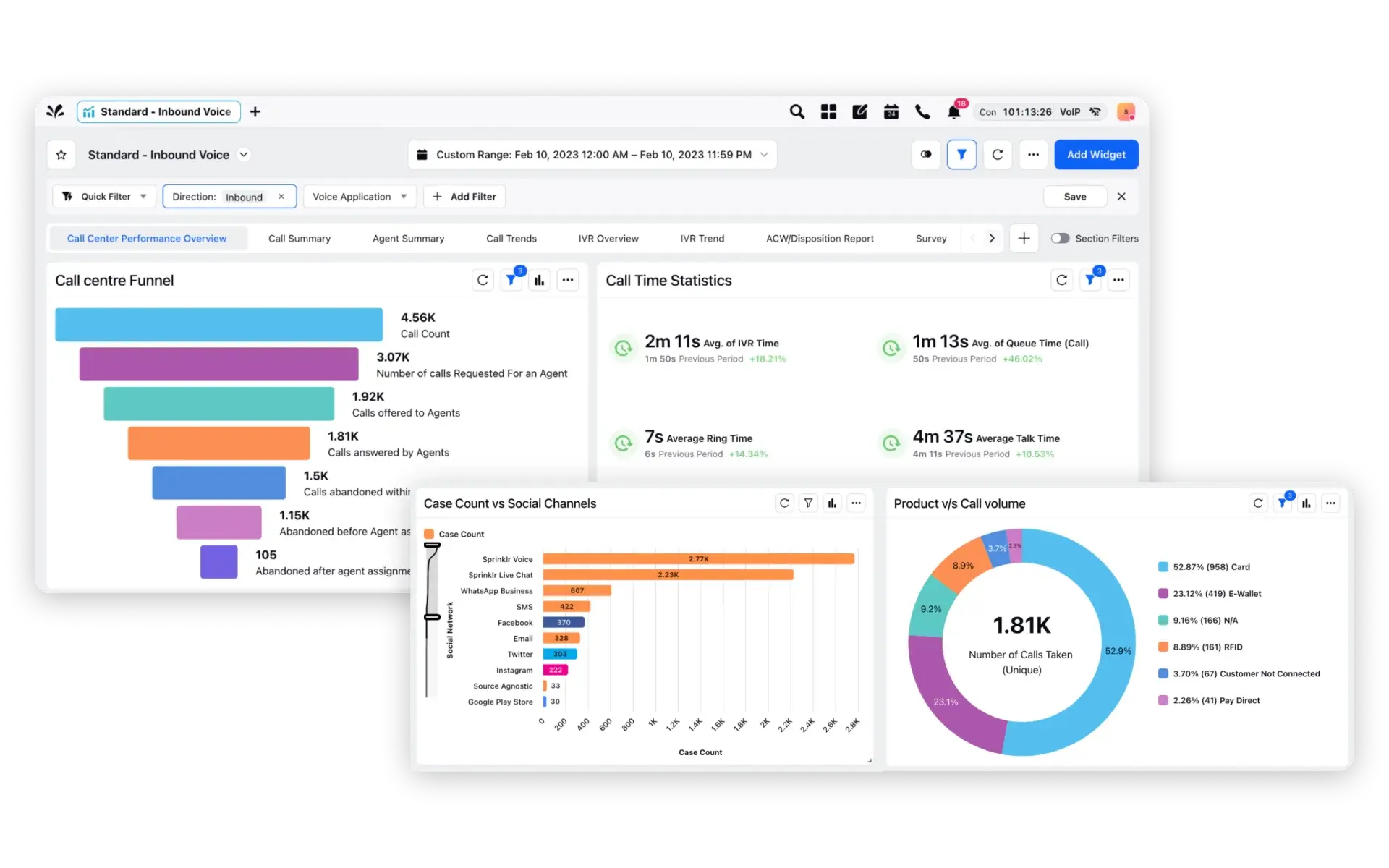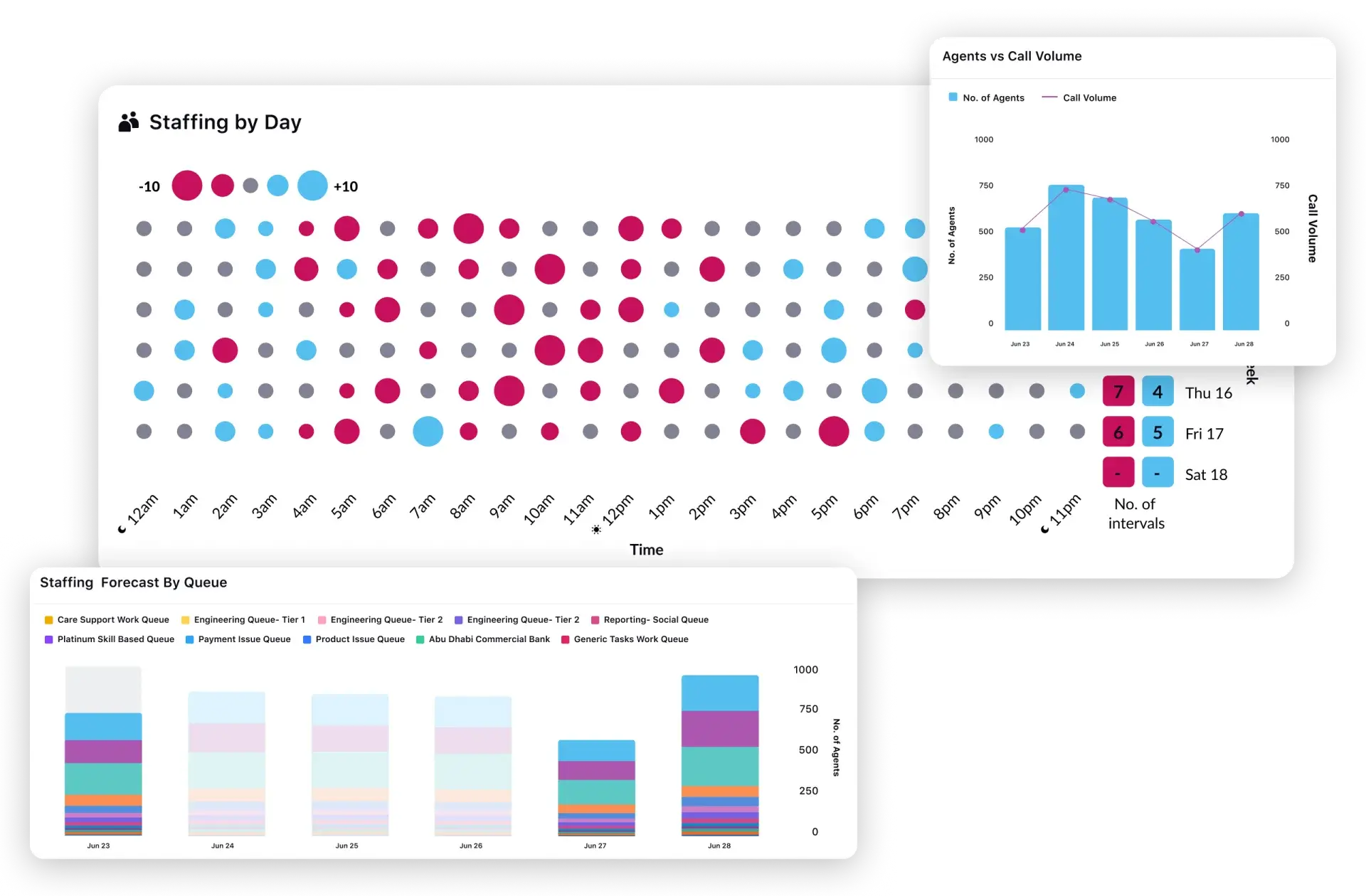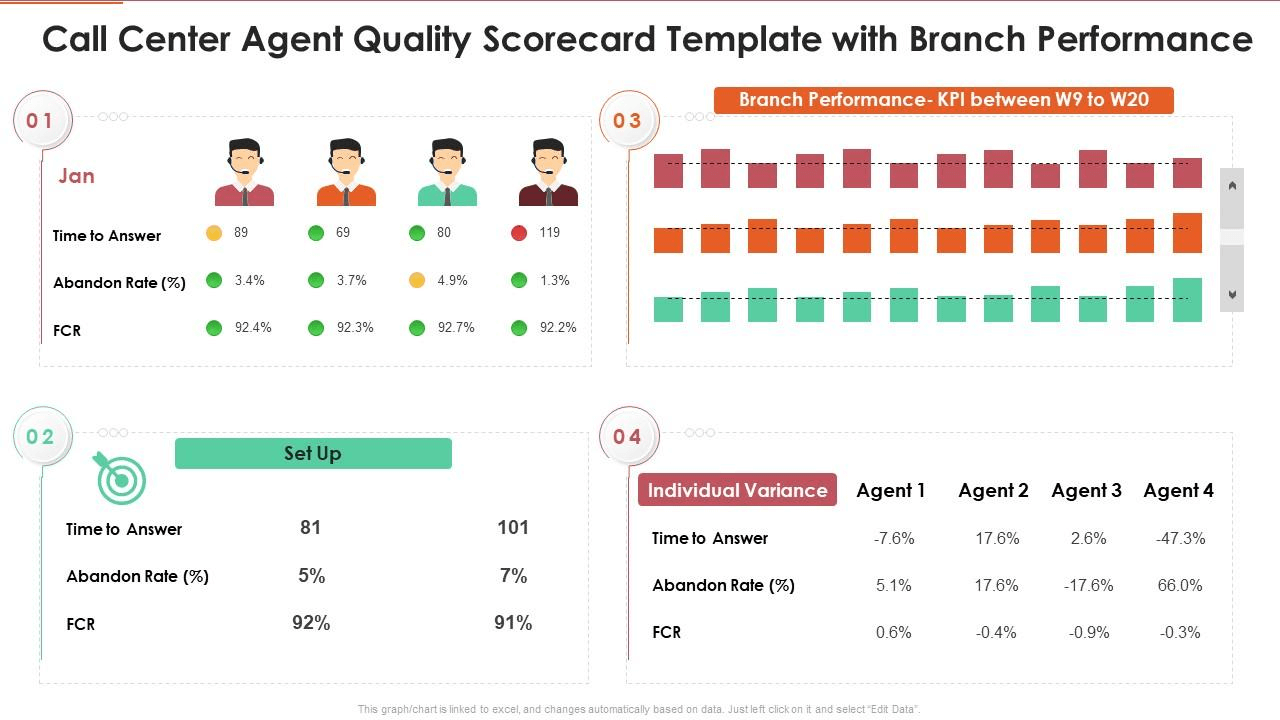What is a blended contact center?
A blended call center refers to a customer service set-up where both incoming and outgoing support calls are managed from a central location. A blended call center combines the features and functionalities of an inbound call center and an outbound call center.
Agents are equipped to receive all kinds of customer support calls and inquiries. Plus, they can initiate calls to customers for proactive support, sales, follow-ups or surveys. In short, your blended call center agents can seamlessly switch between addressing incoming calls and making outgoing calls as the need arises.
The goal is to deliver exceptional customer support while ensuring business growth and customer relationship management.
What are the steps in setting up a blended call center?
To successfully establish a blended call center, it is crucial to follow a systematic stepwise strategy, which can be broken down as follows:
Step 1: Determine your goals and objectives
Start by defining the goals and objectives that you aim to achieve with your blended call center. It may be:
Improving customer service quality or speed
Boosting sales
Lowering operational costs
Enhancing agent happiness
Fostering customer relationships
With clearly-defined objectives and call center KPIs, you get laser-focused direction to decide everything for your blended contact center from staffing to performance management.
Step 2: Pick robust call center software
Now that you know your end-goals, it should be fairly easy to find a feature-rich call center solution that supports both inbound and outbound calling.
When it comes to inbound calling, here are some of the must-have features and capabilities you should look for:
Likewise, for outbound calling, try to find software that offers:
Auto-dialers (with predictive dialing)
Data integration and validation
Call scheduling
Moreover, it’s wise to invest in a call center solution that integrates seamlessly with non-voice channels so your agents can deflect calls to more cost-effective channels like email, WhatsApp or SMS.
Learn more: Essential call center technologies for 2023 and beyond
Step 3: Hire and train blended agents
Assemble a team of call center agents who possess the expertise to handle both inbound and outbound calls proficiently. Ensure they receive adequate trainingin product knowledge, effective communication skills and best practices.
In addition, equip your agents with people-centric skills like customer empathy and active listening. Ensure you give them a conducive environment to manage their job stress and strike a work-life balance, with techniques like box breathing and yoga.

Curious to learn how to manage call center-stress and agent happiness? Read this 7-minute article.
Step 4: Establish call-routing workflows and systems
Incorporate a robust call-routing mechanism that is able to withstand traffic dips and peaks. Your workflows should be able to direct calls to best-matched agents and teams who can deliver first-call resolutions. This kind of skill-based routing ensures increased customer satisfaction as well as top agent productivity.
Step 5: Integrate with your CRM system
Integrate your call center software with your customer relationship management (CRM) system so your agents can access customer information in real time during their conversations. This enables agents to deliver context-rich responses and keep up customer satisfaction levels.
Step 6: Monitor and analyze your blended call center’s performance
Call center quality monitoring will enable you to track performance at various levels – agent level, supervisor level and floor level. Real-time monitoring allows your supervisors to provide immediate feedback and coaching, while data analysis helps identify trends and areas for improvement.
Step 7: Prioritize security and compliance
Ensure that your call center software adheres to strict data security and privacy regulations to avoid data breach of your customers’ vital information. It is also encouraged to look into call center compliance requirements while setting up your blended call center. Watch this video for more information:
Step 8: Test and optimize for performance
Before going live, test all the parts and processes of your blended call center within a simulated environment. Conduct usability testing to spot challenges and issues from real customers. Ensure that you vary the customer sample to cover all your customer demographics and use cases.
Key features of a blended call center
Here are the key features that make blended call centers highly efficient in customer communication and service.
1. Automatic call distribution (ACD)
With ACD working in the background, your incoming calls are auto-routed to agents and teams based on predefined criteria like caller intent, agent expertise, agent availability and more.
This way, customers are promptly connected to the person who can effectively address their inquiries or concerns, which goes a long way toward meeting your service level agreement (SLA).
2. Interactive voice response (IVR)
IVR functions as a receptionist in a blended call center. It welcomes callers, offers them varied self-serve options and then re-directs them to the right department or agent. This reduces your average hold time[SP3] and caller frustration in a big way.
3. Predictive dialing
When it comes to outbound calling campaigns, predictive dialing is a game changer. It employs algorithms to anticipate agent availability and automatically dials numbers from the contact library, connecting agents whenever the call passes through. Your agents spend more time talking, and less waiting on hold.
4. Call monitoring and recording
Call monitoring enables supervisors to listen in on agent-customer interactions in real time, and barge in with assistance if required. It helps your blended call center meet quality and compliance standards. Plus, it gives insights about opportunities for coaching and training. That's not all. It also proves invaluable for resolving customer disputes.
Dive deeper: A detailed guide on call center quality assurance
5. Customer data integration
As explained, blended call centers integrate with customer relationship management (CRM) systems for customer data integration. During phone calls, this integration allows agents to have access to customer details, which helps them personalize responses and understand customer requirements.
6. Real-time analytics and reporting
By analytics and reporting, we mean reports on your call center’s overall performance as well as customer service reports to track metrics such as call volume, average handling time and customer satisfaction.

This data-driven approach facilitates decision-making and continuous improvement in your call center.
What are the advantages of a blended call center?
There’s little doubt that blended contact centers are the way forward for smart businesses. If you are keen to learn more about blended call center benefits, here they are:
1. Cost-effectiveness: Running a blended call center is more cost-effective compared to maintaining separate infrastructures for inbound and outbound operations. Businesses can reduce costs by consolidating resources and infrastructure.
2. Improved efficiency: These call centers optimize agent productivity by eliminating idle time. Agents can seamlessly switch between handling outbound and inbound calls ensuring a smooth workflow and best resource utilization.
3. Enhanced customer service: By leveraging AI-led call routing and deflection, blended call centers are able to reduce your customer response times. Your agents can immediately address inquiries resulting in faster issue resolution and higher levels of customer satisfaction. It can also lead to repeat business and customer loyalty.
82% of consumers claim that they are likely to recommend a product or company if they have received excellent customer service.
4. Increased sales opportunities: Outbound calling enables agents to proactively reach out to customers, follow up on leads and conduct sales campaigns. It can complement your sales efforts and gives you a competitive edge.
5. Flexible workforce management: Your blended call center supervisors have the flexibility to assign agents to inbound or outbound processes based on demand, agent aptitude and other dynamic factors. Workforce management gets simplified and efficient, making it easy to do capacity planning in advance.

What are the disadvantages of a blended call center?
It’s not as if blended call centers are flawless; they do come with certain downsides you should be aware of. By addressing the challenges and leveraging the benefits, your business can create an efficient customer service machine that drives customer satisfaction, boosts sales and contributes to long-term success.
Training challenges: Handling both inbound and outbound calls demands a diverse skill set from call center agents. Training call center agents to excel in both areas can be time-consuming and ongoing.
Complex scheduling: Proper call center scheduling is critical to the success of your blended call center, and it is quite challenging. Managers need to ensure a balance between inbound and outbound calls, which can be challenging during fluctuating call volumes.
Agent fatigue: Constantly switching between inbound and outbound calls can mentally tax agents. Adequate breaks and support are necessary to prevent agent burnout and relieve call center stress.
Inconsistent call volumes: Call volumes for inbound and outbound calls may not always align. During periods of low inbound call volume, agents may have to focus more on outbound calls or perform other non-call-related tasks.
Potential disruption: Introducing a blended call center into an existing call center environment may cause temporary disruption during the transition period. Proper planning and communication are essential to minimize any negative impacts.
If you’re able to combat these challenges, there’s a good chance that your blended call center will become a potent element in your sales and service strategy.
Best practices for a blended contact center
To ace the blended call center, you need to up the stakes by leveraging certain best practices in your operations, people management and overall strategy. Let’s take a look at them.
Tip 1: Focus on real-time performance monitoring and feedback
Implement real-time call monitoring to your team via agent scorecards and other means. Regular coaching sessions based on monitoring insights will help improve your agents’ performance and ensure consistent service quality.

Learn More: How to leverage a call center agent performance scorecard
Tip 2: Give performance incentives
Motivate your overworked blended call center agents by introducing performance-based incentives. Recognizing and rewarding exceptional performance boosts agent morale and encourages them to excel in their roles despite the stressful nature of their job.
Tip 3: Seek customer feedback constantly
It’s vital to have a robust customer feedback mechanism in place to gauge the quality of your support quality. Valuable insights from customers can help identify areas for improvement for your blended call center and fine-tune your operations.
Read more: How to measure customer satisfaction without surveys
Final thoughts
Siloed inbound and outbound call centers can be a big overhead for your business. When you combine the two in a blended call center, you gain unified customer insights that bring down your cost and operational inefficiency.
And things become even better if you opt for an AI-powered, omnichannel solution like Sprinklr Service. You can leverage the power of the world’s leading digital-first, proactive customer service solution to help unlock the next phase of growth.
Ready to elevate your customer service efforts and grow your business revenue?
related products
Thank you for contacting us.
A Sprinklr representative will be in touch with you shortly.
Contact us today, and we'll create a customized proposal that addresses your unique business needs.
Request a Demo
Welcome Back,
No need to fill out any forms — you're all set.


